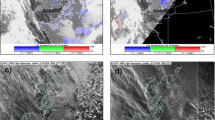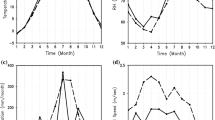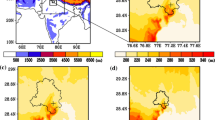Abstract
Major challenges in modelling and forecasting fog are determining the accuracies needed in simulation of meteorological fields that determine the dynamics of fog. In particular, the meso-scale forecasts need to be tested for their ability to distinguish between foggy and non-foggy days for the important variables like wind, humidity and temperature. We evaluate forecasts from a meso-scale atmospheric model over Delhi (28°35′N; 77°12′E), a fog fog-prone metropolis, during the months December and January through 2009–2012. A comparison of composites of hourly forecasts of the meteorological fields of area-averaged 1° × 1° (28°35′N; 77°12′E) surface wind, low-level humidity and air temperatures for the observed foggy and non-foggy days shows that the forecasts do show lower winds, higher humidity and lower temperature in general for foggy days consistent with the known physical conditions for formation of fog over the region. Comparison of differences in simulated meteorological variables for days with no fog, mild fog and dense fog (characterized in terms of hourly visibility) with the corresponding values from observation show consistent and appreciable distinctions in the meteorological variables The contrasts are also found to persist at 850 mb pressure level in both observed and the simulated profiles; once again the observed vertical profiles have distinct characteristics for December and January that are simulated well by the model. Identification of these contrasts can help to calibrate model configuration and to quantify accuracy required in the meteorological forecasts for driving fog prediction models.









Similar content being viewed by others
References
Bang, C. H., Lee, J. W., & Hong, S. Y. (2008). Predictability experiments of fog and visibility in local airports over Korea using the WRF model. Journal of Korean Society for Atmospheric Environment, 24, 92–101.
Bergot, T., & Guedalia, D. (1994). Numerical forecasting of radiation fog. Part I: numerical model and sensitivity tests. Monthly Weather Review, 122, 1218–1230.
Bhowmik, S. K., Roy, Sud, A. M., & Singh, C. (2004). Forecasting fog over Delhi—an objective method. Mausam, 55, 313–322.
Brown, R., & Roach, W. T. (1976). The physics of radiation fog. Part-II: a numerical study. Quarterly Journal of the Royal Meteorological Society, 102, 335–354.
Croft, P. J. (2003). Fog. In Holton, J. R., Curry, J. A., Pyle, J. A. (Eds.), Encyclopedia of Atmospheric Sciences (pp. 777–792). New York: Academic Press
Dimri, A. P., & Chevuturi, A. (2014). Model sensitivity analysis study for western disturbances over the Himalayas. Meteorology and Atmospheric Physics, 123, 155–180.
Dudhia, J. (1989). Numerical study of convection observed during the winter monsoon experiment using a mesoscale two-dimensional model. Journal of Atmospheric Science, 46, 3077–3107.
Fu, G., Guo, J. T., Xie, S. P., Duane, Y. H., & Zhang, M. G. (2006). Analysis and high-resolution modeling of a dense sea fog event over the Yellow Sea. Atmospheric Research, 81, 293–303.
Goswami, P., & Baruah, J. (2011). Urban air pollution: process identification, impact analysis and evaluation of forecast potential. Meteorology and Atmospheric Physics, 110(3–4), 103–122.
Goswami, P., Himesh, S., & Goud, B. S. (2012a). Comparative analysis of the role of domain size, horizontal resolution and initial conditions in the simulation of tropical heavy rainfall events. Meteorological Applications, 19(2), 170–178.
Goswami, P., & Mallick, S. (2011). Objective bias correction for improved skill in forecasting diurnal cycles of temperature over multiple locations: the summer case. Weathar Forecasting, 26(1), 26–43. ISSN: 0882-8156.
Goswami, P., & Mohapatra, G. N. (2014). A comparative evaluation of impact of domain size and parameterization scheme on simulation of tropical cyclones in the Bay of Bengal. Journal of Geophysical Research, 119(1), 10–22.
Goswami, P., Rakesh, V., Patra, G. K., & Prakash, V. S. (2012b). Real-time quantitative rainfall forecasts at hobli-level over Karnataka: evaluation for the winter monsoon 2010. Current Science, 102(10), 1426–1433.
Goswami, P., & Sarkar, S. (2015). Analysis and quantification of contrasts in observed meteorological fields for foggy and non-foggy days. Meteorology and Atmospheric Physics. doi:10.1007/s00703-015-0384-2.
Gultepe, I., Fernando, H. J. S., Pardyjak, E. R., Hoch, S. W., Silver, Z., Creegan, E., et al. (2016). An overview of the MATERHORN fog project: observations and predictability. Pure and Applied Geophysics, 173, 2983–3010.
Gultepe, I., & Isaac, G. A. (2004). An analysis of cloud droplet number concentration (Nd) for climate studies: emphasis on constant Nd. Quarterly Journal of the Royal Meteorological Society, 130(602), 2377–2390.
Gultepe, I., & Milbrandt, J. A. (2007). Microphysical observations and mesoscale model simulation of a warm fog case during FRAM project. Pure and Applied Geophysics, 164, 1161–1178.
Gultepe, I. M., Muller, M. D., & Boybeyi, Z. (2006). A new visibility parameterization for warm-fog applications in numerical weather prediction models. Journal of Applied Meteorology and Climatology, 45, 1469–1480.
Gultepe, I., Pearson, G., Milbrandt, J. A., Hansen, B., Platnick, S., Taylor, P., et al. (2009). The fog remote sensing and modeling (FRAM) field project and preliminary results. Bulletin of the American Meteorological Society, 90, 341–359.
Gultepe, I., et al. (2007). Fog research: a review of past achievements and future perspectives. Pure and Applied Geophysics, 164, 1121–1159.
Gupta, R. K. (1987). On techniques of forecasting fog/stratus over the Dundigal airfield of Hyderabad. Mausam., 38(4), 401–406.
Holtslag, A. A. M., De Bruijn, E. I. F., & Pan, H.-L. (1990). A high resolution air mass transformation model for short-range weather forecasting. Monthly Weather Review, 118(8), 1561–1575.
Hong, S. Y., Noh, Y., & Dudhia, J. (2006). A new vertical diffusion package with an explicit treatment of entrainment processes. Monthly Weather Review, 134(9), 2318–2341.
Jenamani, R. K. (2007). Alarming rise in fog and pollution causing a fall in maximum temperature over Delhi. Current Science, 93, 314–322.
Kain, J. S. (2004). The Kain-Fritsch convective parameterization: an update. Journal of the Applied Meteorology, 43, 170–181.
Lin, Y. L., Farley, R. D., & Orville, H. D. (1983). Bulk parameterization of the snow field in a cloud model. Journal of Climate and Applied Meteorology, 22(6), 1065–1092.
Menut, L., Mailler, Sylvain, Dupont, Jean-Charles, Haeffelin, Martial, & Elias, Thierry. (2014). Predictability of the Meteorological Conditions Favourable to Radiative Fog Formation during the 2011 ParisFog Campaign. Boundary-Layer Meteorology, 150(2), 277–297.
Mlawer, E. J., Taubman, S. J., Brown, P. D., Iacono, M. J., & Clough, S. A. (1997). Radiative transfer for inhomogeneous atmosphere: rRTM, a validated correlated-k model for the long-wave. Journal of Geophysical Research, 102, 16663–16682.
Mohan, M., & Bhati, S. (2011). Analysis of WRF model performance over subtropical region of Delhi, India. Advances in Meteorology. doi:10.1155/2011/621235.
Noh, Y., Cheon, W.-G., & Hong, S.-Y. (2003). Improvement of the K-profile model for the planetary boundary layer based on large eddy simulation data. Boundary-Layer Meteorology, 107, 401–427.
Pagowski, M., Gultepe, I., & King, P. (2004). Analysis and modeling of an extremely dense fog event in southern Ontario. Journal of the Applied Meteorology, 43, 3–16.
Raju, P. V., Potty, J., & Mohanty, U. C. (2011). Sensitivity of physical parameterizations on prediction of tropical cyclone Nargis over the Bay of Bengal using WRF model. Meteorology and Atmospheric Physics, 113, 125–137.
Rakesh, V., & Goswami, P. (2014). Evaluation of high resolution rainfall forecasts over Karnataka for the 2011 southwest and northeast monsoon seasons. Meteorological Applications, 22, 37–47. doi:10.1002/met.1438.
Rakesh, V., Singh, R., & Joshi, P. C. (2011). Evaluation of short-range forecasts from a meso-scale model over the Indian region during monsoon 2006. Pure and Applied Geophysics, 168, 919–943.
Roach, W. T., Brown, R., Caughey, S. J., Garland, J. A., & Readings, C. J. (1976). The physics of radiation fog I—a field study. Quarterly Journal of the Royal Meteorological Society, 102, 313–333.
Román-Cascón, C., Yagüe, C., Sastre, M., Maqueda, G., Salamanca, F., & Viana, S. (2012). Observations and WRF simulations of fog events at the Spanish Northern Plateau. Advances in Science and Research, 8(1), 11–18.
Saraf, A. K., Bora, A. K., Das, J. D., Rawat, Vineeta, Sharma, Kanika, & Jain, Sanjay K. (2010). Winter fog over the Indo-Gangetic Plains: mapping and Modelling using Remote Sensing and GIS. Natural Hazards. doi:10.1007/s11069-010-9660-0.
Skamarock WC, Klemp JB, Dudhia J, Gill DO, Barker DM, Wang W, Powers JG. (2005). A description of the Advanced Research WRF, Version 2. NCAR Technical Note, NCAR/TN-468 + STR, 88. [Available from UCAR Communications, P.O. Box 3000, Boulder, CO 80307].
Steeneveld, G. J., Ronda, R. J., & Holtslag, A. A. M. (2015). The challenge of forecasting the onset and development of radiation fog using mesoscale atmospheric models. Boundary-Layer Meteorology, 154(2), 265–289.
Vautard, R., Yiou, P., & Van, Oldenborgh G. J. (2009). Decline of fog, mist and haze in Europe over the past 30 years. Nature Geoscience, 2, 115–119.
Welch, R. M., & Welicki, B. A. (1986). The stratocumulus nature of fog. Journal of Applied Meteorology, 25, 101–111.
Zhou, B., & Ferrier, B. S. (2008). Asymptotic Analysis of Equilibrium in Radiation Fog. Journal of Applied Meteorology and Climatology, 47(6), 1704–1722. doi:10.1175/2007JAMC1685.1.
Acknowledgements
This work was supported by the project “High Resolution Regional Atmospheric Analysis (HiRRA)”, funded by CSIR, Government of India. The high-performance computing (HPC) facility of CSIR Centre for Mathematical modeling and Computer Simulation (CSIR-4PI) has been used for computing. The hourly visibility data and the fog satellite imageries were downloaded from India Meteorological Department (IMD) website http://www.imd.gov.in/section/nhac/dynamic/fogvis1.html. The radiosonde observations were taken from Department of Atmospheric Science, University of Wyoming (http://weather.uwyo.edu/upperair/sounding.html) at 00 UTC over Safdurjung airport, Delhi.
Author information
Authors and Affiliations
Corresponding author
Electronic supplementary material
Below is the link to the electronic supplementary material.
Rights and permissions
About this article
Cite this article
Sarkar, S., Goswami, P. An Assessment of Forecast Skill of an Atmospheric Meso-scale Model in Simulating the Observed Contrasts in Meteorological Fields for Foggy and Non-foggy Days. Pure Appl. Geophys. 174, 2827–2845 (2017). https://doi.org/10.1007/s00024-017-1537-7
Received:
Revised:
Accepted:
Published:
Issue Date:
DOI: https://doi.org/10.1007/s00024-017-1537-7




